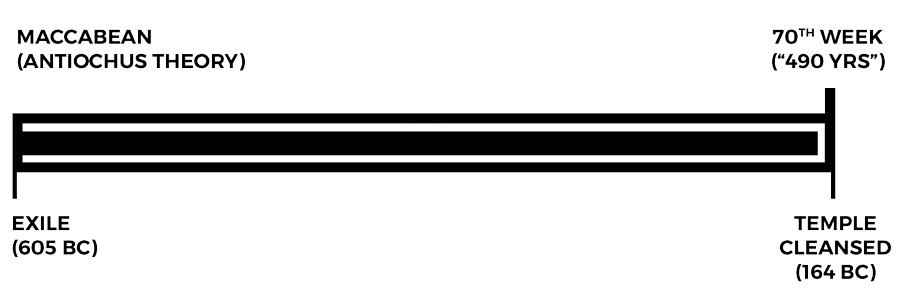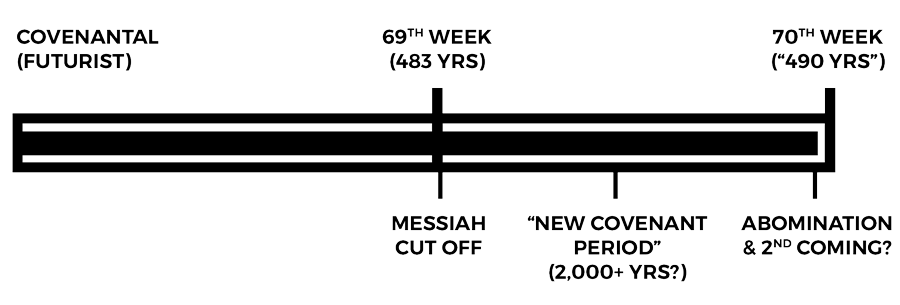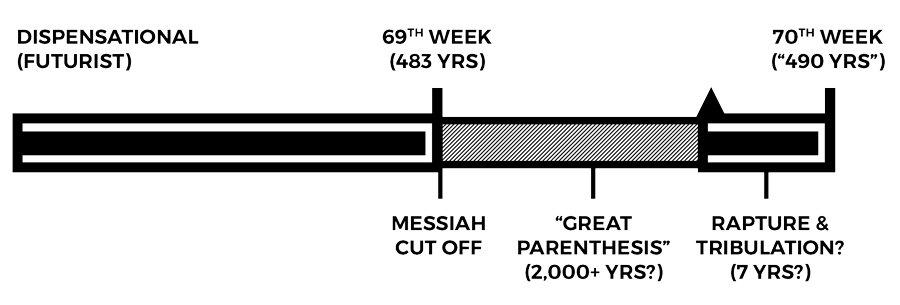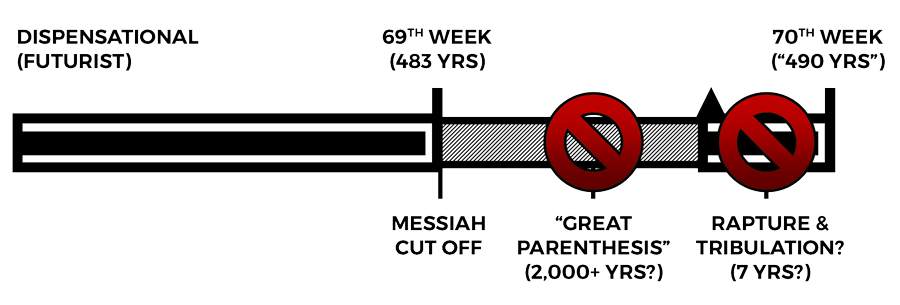Small Group Leader Guide
Step 1. Introduce the Session
5 minutes
Daniel’s 70-week prophecy (Daniel 9:24-27) has been said to be the most spectacular and most exacting prophecy in all of Scripture, foretelling the Messiah’s arrival, death and the destruction of Jerusalem in 70 AD with amazing accuracy.
SESSION GOAL(S)
- Get grounded on one of the most important and amazing prophecies in the Bible.
Step 2. Watch the Video
29 minutes
CONTENT SUMMARY (with timestamps)
- Daniel 9:24-27 (KJV) (02:04)
- 70 Weeks? Understanding Heaven’s Prophetic Timer (03:15)
- Verse 24 (Continued) (04:49)
- Verse 25 (07:43)
- Where Do We Start? (10:23)
- Verse 26 (12:47)
- Verse 27 (14:33)
- 4 Past Lenses For Understanding This Prophecy (17:42)
- Bad Math (Solved) (21:32)
- But It Doesn’t All Fit, Does It? (23:39)
- No End-Time Tribulation Then? (24:31)
- What About The Last 3½ Years? (25:01)
- A Calculated Curse (25:38)
- Spotted: Daniel’s 70 Weeks (26:40)
- The Prophecy Has Been Fulfilled (28:07)
Step 3. Discuss
15 minutes
Leaders: You might like to split into smaller groups at this stage so everyone has a chance to respond honestly. Don't feel like you have to hurry through all these questions; they are simply conversation starters.
Q. What did you find most helpful or most challenging in this lesson? Any surprises?
Q. Of the five views people use to understand this prophecy—Maccabean, Covenantal, Dispensational, Historical or Literal—which one resonates most for you? Why?
Q. Regardless of your starting point for this prophecy, it is clear it culminates in war and the destruction of the Temple (v26). Messianic expectation rose to a fever pitch throughout first-century Judaea. What mistakes might be made when prophetic scriptures are wrongly interpreted?
(Hint: Christianity has also done this across the centuries. Remember the many examples from lesson three, “You’re Probably Wrong”. Answers might include falling prey to cons and false messiahs, rushing to war, quitting jobs, breaking off relationships, canceling investments, etc.)
Q. Imagine you have good reason to believe the Messiah is coming within a year. How would you live differently? Where would you place your focus? If you would live differently, what keeps you from making those changes now?
Step 4. Report Out [OPTIONAL]
15 minutes
Leaders: If you’re a team of leaders taking a class through the course and you broke into small groups in Step 3, regroup at the end and ask each small group to report out on their small group discussion. What were their ah-ha’s? What did they struggle with?
Close with prayer.
[TRANSCRIPT FOLLOWS]
SESSION 7
Daniel's 70 Weeks Prophecy
(Daniel 9:24-27, Leviticus 28:5)
Imagine being visited by an angel and receiving a promise foretelling a future king who would liberate your people and usher in an entirely new kingdom—a new way of life—free from the crushing burden of sin, shame and guilt. Amazing! But then this promise turns dark, tainted by war, desolation and the end of all you’ve ever known.
Oh, and did I mention this prophecy is wrapped in an exact timeframe so your people can know when all this is going to go down?
Welcome to Daniel’s 70-Week Prophecy.
TAKE-AWAYS FROM THIS LESSON
- This prophecy gives a precise timeline
- Announces the arrival of Israel’s Messiah
- Predicts the Messiah’s death
- Predicts the destruction of temple and Jerusalem by an army
- Jesus reminds His first-century followers of this prophecy to warn them of the impending 70 AD judgment (Matthew 24:15)
Israel has been in captivity for almost 70 years, ever since the Babylonian invasions of 605 and 586 BC. As chapter 9 of the Book of Daniel opens, we find Daniel studying the prophet Jeremiah and recognizing Israel's exile is almost over: "And this whole land shall be a desolation, and an astonishment; and these nations shall serve the king of Babylon seventy years." (Jeremiah 25:11) For most of this chapter, Daniel is pouring himself out, repenting on behalf of Israel, but then he is interrupted by the angel Gabriel who delivers a prophecy we commonly refer to as Daniel’s 70 Weeks (Daniel 9:24-27). Here it is, in its entirety, according to the King James version, which I feel offers a truer reading of this passage than many other Bible versions:
Daniel 9:24-27 (KJV)
24 Seventy weeks are determined upon thy people and upon thy holy city, to finish the transgression, and to make an end of sins, and to make reconciliation for iniquity, and to bring in everlasting righteousness, and to seal up the vision and prophecy, and to anoint the most Holy.
25 Know therefore and understand, that from the going forth of the commandment to restore and to build Jerusalem unto the Messiah the Prince shall be seven weeks, and threescore and two weeks: the street shall be built again, and the wall, even in troublous times.
26 And after threescore and two weeks shall Messiah be cut off, but not for himself: and the people of the prince that shall come shall destroy the city and the sanctuary; and the end thereof shall be with a flood, and unto the end of the war desolations are determined.
27 And he shall confirm the covenant with many for one week: and in the midst of the week he shall cause the sacrifice and the oblation to cease, and for the overspreading of abominations he shall make it desolate, even until the consummation, and that determined shall be poured upon the desolate.
70 Weeks? Understanding Heaven’s Prophetic Timer
While prophets point to Israel's lack of justice as the reason for judgment, 2 Chronicles 36:20-21 shows us Israel’s 70-year exile corresponds with their 490-year refusal to give the land its Sabbath rest every seven years (per Leviticus 25:3-5; 26:33-35):
20 And them that had escaped from the sword carried he away to Babylon; where they were servants to him and his sons until the reign of the kingdom of Persia:
21 To fulfil the word of the Lord by the mouth of Jeremiah, until the land had enjoyed her sabbaths: for as long as she lay desolate she kept sabbath, to fulfil threescore and ten years [70 years].
As Daniel repents on behalf of his nation and petitions for the Lord's mercy, Gabriel calls Daniel to "understand the matter and consider the vision." Another 490-year time period is predicted in the opening verse.
“Seventy weeks are determined”; The timeframe for prophetic fulfillment is 70 weeks, or 70 sets of seven years, equaling a total of 490 years.
Wait. “Weeks of years?” Where does that idea come from? I’m glad you asked! Back in Leviticus 25:8—as God instructs Moses on Mt. Sinai—it’s God Himself who introduces to the concept of weeks of years (also known as “heptads”):
8 And thou shalt number seven sabbaths (i.e. weeks) of years unto thee, seven times seven years; and the space of the seven sabbaths of years shall be unto thee forty and nine years.
Feel like there are a lot of sevens going on? There are. Remember that seven is heaven’s number for perfection and completeness, whether that means perfect judgment or perfect redemption.
Verse 24 (Continued)
Now that we have the 70-weeks thing figured out, let’s deal with the rest of verse 24:
24 Seventy weeks are determined upon thy people and upon thy holy city, to finish the transgression, and to make an end of sins, and to make reconciliation for iniquity, and to bring in everlasting righteousness, and to seal up the vision and prophecy, and to anoint the most Holy.
“Upon thy people and upon thy holy city”; It is important to note who this prophecy is for: Daniel’s people, Israel, and their holy city, Jerusalem. 70 weeks (490 years) are given to the nation of Israel and the city of Jerusalem to make straight the way for their Messiah. By the end of this time, several things will be finished:
“To finish the transgression”; 1 John 3:4 reminds us, “Whosoever commits sin transgresses also the law: for sin is the transgression of the law,” but Galatians 3:25 frees us, “Now that this faith has come, we are no longer under a guardian [the law.]” (See also Isaiah 53:5.)
“To make an end of sins”; How was this done? By conquering death and the effects of the Fall, including the mindsets and heart positions that have resulted from being cut off by the curse. "What shall we say, then? Shall we go on sinning so that grace may increase? By no means! We are those who have died to sin; how can we live in it any longer?" (See also Isaiah 53:10 and Romans 6:1-2.)
“To make reconciliation for iniquity”; The Messiah would bridge the gap created by sin between us and the Father, stretching all the way back to the Fall. Per Hebrews 2:17: “Wherefore in all things it behooved him to be made like unto his brethren, that he might be a merciful and faithful high priest in things pertaining to God, to make reconciliation for the sins of the people.” (See also Isaiah 53:6 and Romans 3:25.)
“To bring in everlasting righteousness”; By re-establishing us as sons and daughters in His image, we are restored to the very image of Christ. Jesus came not only to pay for our sins but to restore our kingdom identities. (Luke 19:10) “If we confess our sins, he is faithful and just to forgive us our sins, and to cleanse us from all unrighteousness.” (1 John 1:9)
“To seal up the vision and prophecy”; 490 years are determined to bring final fulfillment to this Messianic prophecy.
“To anoint the Most Holy”; Exalting the Son of Man before the Ancient of Days and establishing His rule over the nations of the world. “All authority has been given to Me...” (Matthew 28:18). (See also Psalm 110, Daniel 7:13-14, and Hebrews 10:12-13.)
Verse 25
25 Know therefore and understand, that from the going forth of the commandment to restore and to build Jerusalem unto the Messiah the Prince shall be seven weeks, and threescore and two weeks: the street shall be built again, and the wall, even in troublous times.
“Going forth of the commandment to restore and build Jerusalem”; This gives us our starting point! Almost! But people can’t agree when this happened! When I first discovered the 70-Week prophecy, I heard Bible teachers boast about how to-the-day their calculations were. Yet, when I started doing the math, it became difficult to get things to line up as perfectly as they claimed. Were they using a Gregorian solar calendar or were they using one of the Jewish lunar calendars? Which edict were they starting from? We’ll cover all this more in a moment.
“Unto the Messiah the Prince”; Some try to say the messiah referenced here is the Persian king, Cyrus, who conquered Babylon and granted the Jewish people permission to return to their homeland. They cite Isaiah 45:1, where Cyrus is referred to as God's "anointed servant" (literally, "my messiah"). While Cyrus certainly initiated the first phase of the return, Daniel's messiah was to arrive 69 sevens (483 years) after the command to return, so Cyrus can’t be thee Messiah.
“Seven weeks, and threescore and two weeks (7 + 62)”; The prophecy is broken into seven weeks (49 years to rebuild and restore Jerusalem) and 62 weeks (where 434 years seems to coincide with the period of prophetic silence that separates the Old Testament from the New) giving us a total of 69 weeks (483 years) for Messiah to arrive on the scene, bringing us to Jesus’ baptism.
“The street shall be built again, and the wall, even in troublous times”; The edicts to restore Jerusalem’s infrastructure and defenses are recorded in Ezra and Nehemiah.
Where Do We Start?
Circling back to “going forth of the commandment to restore and build Jerusalem,” the Bible shows us four decrees by three Persian kings given in regards to rebuilding Jerusalem:
- Cyrus, between 539-536 BC, authorized rebuilding the temple. (Ezra 1:1-4)
- Darius 1 Hystapes, around 519 BC, only reconfirmed Cyrus' decree. (Ezra 6:1-12)
- Artaxerxes, in his 7th year, between 457-458 BC, restores Jewish government. (Ezra 7:11-28)
- Artaxerxes, in his 20th year, around 444-445 BC, authorizes rebuilding the wall. (Nehemiah 2:1-8)
I’m going to spare you the technical arguments for Cyrus versus Artaxerxes, but since I detailed them before I remembered my students’ sanity really was important to me, I’ll footnote the basic arguments in the transcript for this lesson.[1]
The short answer? No one agrees and everyone has their favorite.
The Bible seems to favor Cyrus who undoubtedly launched Israel’s restoration exactly 70 years after their Babylonian exile began. However, 483 years after his decree seems to be about 80 years too early for Jesus. No worries! There are a few scholars who say the chronology for this segment of history is also off—by about 80 years—but others would disagree. Artaxerxes’ proponents are divided between his two decrees based on their timing and the fact that his first decree seems to restore pretty much everything but the second decree calls out the city’s defensive walls specifically.
Guess what? The pressure is off! You don’t have to be certain about which decree starts this prophecy! All four decrees see the full 490-year timeline completed before the fall of Jerusalem in 70 AD. As we see in verse 26, the Jewish Messiah had to arrive before the destruction of the second temple.
Verse 26
26 And after threescore and two weeks shall Messiah be cut off, but not for himself: and the people of the prince that shall come shall destroy the city and the sanctuary; and the end thereof shall be with a flood, and unto the end of the war desolations are determined.
“After threescore and two (62) weeks”; During the 69th and final week of the prophetic timeline, sometime during the seven years following the 483rd year but before the 490th year.
“Shall Messiah be cut off, but not for himself”; The Messiah will be killed, but not for Himself (and certainly not on account of His own guilt.) (Isaiah 53:11, Luke 23.) The Jewish Messiah would be the final spotless sacrifice for the removal of sin. Say, did I mention the Messiah had to be cut off before the destruction of the second temple? Yeah, I did.
“The people of the prince shall destroy the city and the sanctuary”; Here we are no longer referring to Messiah. History has revealed this prince to be the Roman general Titus Vespasian and the Roman army who laid siege and destroyed Jerusalem and the temple in 70 AD.
“And the end shall be with a flood”; This refers to a torrent of people (here, the Roman army), similar to the poetic prophetic imagery describing the Assyrian army in Isaiah 8:7-8.
“Unto the end of the war desolations are determined”; The War of the Jews began in 66 AD and lasted until 73 AD, climaxing with the siege of Jerusalem, the destruction of the second temple and the end of Jewish religious order in 70 AD.
Verse 27
27 And he shall confirm the covenant with many for one week: and in the midst of the week he shall cause the sacrifice and the oblation to cease, and for the overspreading of abominations he shall make it desolate, even until the consummation, and that determined shall be poured upon the desolate.
“And he shall confirm the covenant with many for one week”; If Daniel’s 70-Week prophecy had stopped at verse 26, most of us would have been way less confused. Without a doubt, verse 27 has proved to be one of the more troublesome passages in the Bible.
Who is the “he” who will “confirm the covenant with many for one week?” Theories here include the Messiah or Titus (both referenced in verse 26), a demonic principality positioned over Rome (inferred by the “Prince of Persia” and “Prince of Greece” references later in Daniel 10:13, 20) or a future villain known as “Antichrist”.
Remember recapitulation, where the Bible gives one account and then doubles back to retell with additional color? Well verse 27 is an example of recapitulation.[2] “He” refers back to the Messiah who “confirmed the covenant with many” (Luke 22:2, Matthew 26:28: "For this is my blood of the new covenant, which is shed for many for the remission of sins.") Though the action within v26 and v27 is presented as redemption-destruction-redemption-destruction, once the two verses are overlaid, a single redemption-destruction pattern aligns and it all points to Jesus.
“In the midst of the week”; Jesus died in the middle of the prophetic seven-year week; we know His ministry lasted about 3½ years. In Luke 3:23, we learn Jesus began his ministry at "about 30 years of age" and John records three Passover events during Jesus' ministry (John 2:13, 6:4, 11:55.)[3]
“Shall cause the sacrifice and the oblation (offering) to cease”; His perfect, sinless sacrifice brought the Old Covenant Jewish sacrifices to an end, rendering any continuation of them null and void (Hebrews 10:9).
“For the overspreading of abominations he shall make it desolate”; As Jesus promised, He returned within a generation—not physically, but in “coming in the clouds, Day of the Lord” national judgment (Matthew 24:30, Matthew 26:64, Joel 2:11).
“Even until the consummation”; This refers to the consummation of the Jewish Old Covenant religious order in 70 AD.
“And that determined shall be poured upon the desolate”; That is, this prophesied judgment shall be poured out upon the unbelieving Jewish nation.
4 Past Lenses for Understanding This Prophecy
Remember: These can all be wrong but they can't all be right! Historically, there are at least four different ways people have tried to unpack this prophecy…
Maccabean View (Nonorthodox)
Otherwise known as the Antiochus Theory, this view holds that the 70-week timeline is figurative, being symbolic for the time the Jews were in exile leading through their rebuilding and extending all the way into the end of the Maccabean war which was complete by 164 BC with the cleansing of the temple and the death of Antiochus IV Epiphanes.

Objections to this view: How could the events around Antiochus IV fulfill key phrases such as “to finish the transgression,” “to make an end to sin,” and “to bring everlasting righteousness”? Additionally, the Maccabean view fails to take seriously the “weeks” time period established in Leviticus 25:8 but still borrows time from the very exile that resulted from Israel’s disregard of it. [4] Of the four views listed here, this view is the only one considered to be nonorthodox by Christianity and is the favored view held by modern-day Judaism.
Covenantal View (Futurist)
Using Cyrus’ decree as its starting point, this view largely allegorizes the 70 weeks. Though the Covenantal timeline comes close by placing the 69th week at Jesus’ crucifixion, it then advances a 70th week that lasts until Jesus’ future second coming in a time called the “New Covenant Period.”

Objections to this view: Makes a loose attempt at the Old Testament witness of seven-year “weeks” established in Leviticus until it renders a 70th week that stretches out for centuries where it then seeks its eventual fulfillment in a misunderstanding of Matthew 24’s “abomination of desolation” and the return of Christ.
Dispensational View (Futurist)
Relatively new and unfortunately popular, this view was first made famous by the Scofield Reference Bible published in 1909. The Dispensational timeline begins from one of the Artaxerxes decrees (opinions vary), and extends its 69th year to Jesus’ Triumphal Entry into Jerusalem (30 or 33 AD.) Upon the Jewish rejection of Jesus, this view inserts an indeterminate expanse of time (currently about 2,000 years) referred to as “the Great Parenthesis” or the “Church Age” which will be terminated by the future rapture of the Church and the emergence of an antichrist who will default on a covenant with the Jewish nation.

Objections to this view: Like its Covenantal cousin, the Dispensational view ignores the recapitulation of v27 and instead imports a time gap spanning thousands of years—well after the prophesied 490 years are up. There is zero precedent for this in the biblical record, however. This gap is created to make room for a future antichrist caricature and seven years of end-time tribulation prior to Jesus’ return.
Reformed Historical View (Preterist)
This view begins with Cyrus’ decree and establishes the beginning of the 69th week at Jesus’ baptism. It then lengthens a 70th week to the destruction of the city and temple in 70 AD.

Objections to this view: While this view rightly aligns the 69th week with the beginning of Jesus’ ministry and understands the recapitulation in verse 27, it still struggles with a 70th week and how to reconcile the predicted fall of Jerusalem 40 years later.
Ah, the struggle is real! Let’s talk about all this bad math.
Bad Math (Solved)
If we say a cup can hold 10 ounces, we know 10 ounces is the limit; it will overflow at 11. If we say a meeting will be an hour, we don’t expect that means two hours. But all too often, folks take the limitation of “70 weeks” and try to expand a timeline well beyond.
There is a fifth view we'll want to consider. Though it's simply a correction to the Historical view, I'm calling this view the Literal view, as it takes the predicted 490 years to be just that—490 years. Remember: The continuous 490-year precedent was already affirmed in 2 Chronicles 36:21. There is no reason to believe a subsequent 490-year timeframe should be 1) allegorized or 2) perforated by any gaps.
Literal View (Preterist)
The math here is simple: 7 weeks + 62 weeks = 69 weeks (or 483 years.) At 69 weeks, Messiah is on the scene (beginning with Jesus' baptism.) He’s cut off (but not for Himself) after the 62 weeks, which means He’s killed somewhere in week 69—the seven years after year 483 but before year 490 (the end of this prophetic timeline.)

So when verse 27 says, “He shall confirm the covenant with many for one week; and in the midst of the week He shall cause the sacrifice and oblation to cease…” this is not tacking on thousands of years as some teach! Verse 27 recapitulates back into the Messiah’s ministry, showing us a time when He would put an end to sacrifice and offering. We know this happened at the cross, which was about 3½ years into Jesus’ earthly ministry; about halfway through the 69th week (i.e. “in the midst of the week”).
Again, this whole prophecy was to be wrapped up within 490 years!
But It Doesn’t All Fit, Does It?
Some rightly argue the fall of Jerusalem didn’t happen for almost 40 years (a biblical generation) after Jesus was crucified. This seems to place part of the prophecy outside the 490-year timeframe. Correct. Remember: The six deliverables for this prophecy are largely related to establishing the kingdom of God: “to finish the transgression, and to make an end of sins, and to make reconciliation for iniquity, and to bring in everlasting righteousness, and to seal up the vision and prophecy, and to anoint the most Holy.” While the impending destruction of the city and temple are foretold, it is not one of the time-bound deliverables established at this prophecy’s introduction. Its only chronological dependency seems to be that this destruction comes after the Messiah.
No End-Time Tribulation Then?
To be clear, I’m not saying there is no end-time tribulation scheduled. I’m simply saying—that though many like to use this prophecy to make their argument for an antichrist and a seven-year end-time tribulation—this prophecy of the 70 Weeks doesn’t actually teach one. Per the first two words of this prophecy, “seventy weeks,” is the heavenly timeline given for its fulfillment. Anything else is eisegetical gymnastics.

What About the Last 3½ Years?
What about them? We don’t really have to do anything with the last 3½ years, though many tie these years to the birth of the early church, culminating in the stoning of Stephen which served to spread the Gospel as Judeo-Christian believers fled persecution in Jerusalem. You can pin this time to the Judeo-Christian diaspora if you need closure on those last 3½ years, but this prophecy doesn’t speak to that exodus, so it’s not really necessary.
A Calculated Curse
Finally, there is the small matter of a Jewish curse over whomever would calculate the timeframe of this prophecy. (Yes, I saved this for the end.)
“Blasted be the bones of those who calculate the end. For they would say, since the predetermined time has arrived, and yet he has not come, he will never come. But [even so], wait for him, as it is written, Though he tarry, wait for him…” (Talmud Sanhedrin 97b, Soncino edition, p. 659.)
Daniel’s 70-Week prophecy so clearly and exactly points to the Messiah’s arrival, His death and Israel’s judgment that centuries later, Jewish rabbis—still refusing to accept Jesus as the Messiah—discouraged the study of the 70-Week prophecy and pronounced this curse over anyone who would calculate its due date or even lament over its apparent lack of fulfillment.
Spotted: Daniel’s 70 Weeks
The prophecy of Daniel’s 70 Weeks shows up several times in Scripture. Besides our Lord’s reference to it in Matthew 24, we possibly see it in a few other places:
- How did the magi know the time was close for the Messiah to arrive? Did they use this prophecy? Though we don’t know for sure, this prophecy may have been one of the keys the magi used to determine the time of Jesus’ birth. Knowing the Hebrew priests began their ministries at age 30 (Numbers 4:43), the wise men could have simply subtracted 30 from the beginning of the 69th week to arrive at the time of the Messiah’s birth.
- The 70 Weeks declaration of national doomsday foreshadows the omitted portion of Christ’s Isaiah 61 reading (Luke 4:16-21). “To proclaim the acceptable year of the LORD, and the day of vengeance of our God; to comfort all that mourn…”
- When Jesus launches at the crowds in Luke 12:56, "You hypocrites! You can discern the face of the sky and of the earth but how is it you do not discern this time?" He may be thinking of this prophecy.
- When Jesus answers Peter on how many times we should forgive others, His answer is “…not seven times but seven times 70 times.” (Matthew 18:21-22 KJV) Our Lord is referring to this prophecy of the 70 weeks, where Israel was extended plenty of time and patience to prepare for the Messiah.
The Prophecy Has Been Fulfilled
There you have it. Daniel’s 70-Week prophecy, in a nutshell. This stunning 490-year prophecy foretells the coming of the Jewish Messiah, His work to inaugurate the kingdom of God, His New Covenant with the many, and the destruction of Jerusalem and the temple at the hands of the Roman army. The Messiah arrived, on time, as planned, and this prophecy has been fulfilled, exactly as predicted.
I hope you have enjoyed this lesson. Remember: It’s the Truth that sets you free.
FOOTNOTES
[1] Cyrus Vs Artaxerxes
The Argument for Cyrus
Speaking through His prophet, Isaiah (44:28), the Lord says: “That saith of Cyrus, He is my shepherd, and shall perform all my pleasure: even saying to Jerusalem, thou shalt be built; and to the temple, thy foundation shall be laid.”
Doesn’t this mean Cyrus’ 536 BC decree (Ezra 1:3) to rebuild the temple is the start of the 70 Week prophecy? Well, it was actually Cyrus who started the trend of restoring the Jewish people from their 70 years of captivity. His decree spells the beginning of the end for Israel’s Babylonian captivity. Even Jewish historian Josephus points to Cyrus in his Antiquities of the Jews (Book 11, chapter 1) where he says, “He gave them leave to go back to their own country, and to rebuild their city Jerusalem, and the temple of God;”
In this way, Cyrus is quite responsible for the movement to restore Jerusalem, but there is a slight problem. If one counts 490 years back from 539 BC you arrive at 49 BC which has exactly zero historical significance for our purposes here. Yet there is a theory among certain scholars that points to an (approximately) 80-year correction to be made in the historical chronology for that time period. Bible scholar Steve Gregg reports on this:
[Phillip] Mauro, [Martin] Anstey (even Scofield changed his view from the Artaxerxes date to the Cyrus date after reading Anstey [Scofield, What Do The Prophets Say? (Philadelphia: Sunday School Times, 1916), p.142), though the Scofield Bible notes were not corrected):
‘Ussher, Lloyd, and others have all based their chronological conclusions on the canon of Ptolemy, a list of Persian kings and the length of time they reigned. But as Mauro says: “Ptolemy does not even pretend to have had any facts as to the length of the Persian period (that is to say, from Darius and Cyrus down to Alexander the Great)”; his dates are based on “calculations or guesses made by Erathosthenes, and on certain vague floating traditions.”’ (Great Prophecies of the Bible, 95)
Not all scholars agree with this, of course.
The Argument For Artaxerxes
Well, it may surprise you that those who argue for Artaxerxes don’t all agree on which of his two edicts to begin from. Some Artaxerxes fans say his first decree around 457 BC seems the most complete. Given to Ezra (7:11-28), this decree authorized the rebuilding of the city of Jerusalem, reestablished Jewish law and government and restored the Jews to their independence. Proponents of this edict say Artaxerxes’ second decree—given to Nehemiah in the 20th year of Artaxerxes’ reign (Nehemiah 2:1-8)—merely helped reinforce his first decree. Furthermore, 457 BC minus 490, minus 3 when Messiah was cut off, puts us roughly around 30 AD which is argued to be one of the potential years for Christ’s crucifixion. Still others say it’s the second Artaxerxes decree that allows for restoring both the temple, city of Jerusalem, and—most importantly—the city wall.
The dates for the decrees of Artaxerxes are well-established and historically secured by four sources of evidence being Greek historians, Ptolemy's Royal Canon (which we just heard could be a little flakey), Babylonian business tablets, and the Elephantine papyri from Egypt.
[2] “These verses are best understood in an A-B-A'-B' pattern. They tell about the seventieth week, which received the most attention in Gabriel’s message to Daniel:
- ‘And after the sixty-two weeks, an anointed one shall be cut off and shall have nothing.’ (v. 26a)
- ‘And the people of the prince who is to come shall destroy the city and the sanctuary. Its end shall come with a flood, and to the end there shall be war. Desolations are decreed.’ (v. 26b)
A'. ‘And he shall make a strong covenant with many for one week, and for half of the week he shall put an end to sacrifice and offering.’ (v. 27a)
B'. ‘And on the wing of abominations shall come one who makes desolate, until the decreed end is poured out on the desolator.’ (v. 27b)
“In this structure, A and A' refer to the same event: the sacrificial work of the anointed one. Sections B and B' each have a single event in mind as well: the destruction of Jerusalem and its temple.” (Chase, 2018.)
[3] The third Passover is further detailed across John 12:1, 13:1, and John 19:14.
[4] The Maccabean view only gives an approximate fulfillment of the 70 weeks, since 490 years after 605 is 115 BC and 490 years after 586 is 96 BC.
REFERENCES
Abbott, Shari. December 15, 2019. “How Did the Wise Men (Magi) Know This Was the Messiah? How Did They Know to Follow His Star?” Reasons for Hope*. Retrieved from https://reasonsforhopejesus.com/wise-men-still-follow-his-star/.
ad Dei Gloriam Ministries. “The Seventy Weeks of Daniel 9, Four Interpretations.” Retrieved from https://www.addeigloriam.org/commentary/ot-prophets/seventy-weeks-of-daniel.htm.
Amazing Discoveries. “Rabbinic Curse.” Retrieved from https://amazingdiscoveries.org/AD-Header-Downloads-References-RabbinicCurse.
Casebolt, Donald. “What is the 70 week prophecy of Daniel 9:24-27?” BibleInfo.com. Retrieved from http://www.bibleinfo.com/en/questions/70-week-prophecy-daniel.
Chase, Mitchell. October 13, 2018. “What Are the Seventy Weeks of Daniel? (Daniel 9).” Crossway. Retrieved from https://www.crossway.org/articles/what-are-the-seventy-weeks-of-daniel-daniel-9/.
De Haan, Mart. “An Amazing Prediction.” Our Daily Bread. Retrieved from https://ourdailybread.org/article/an-amazing-prediction/.
Gregg, Steve. “The 70 ‘weeks’ of Daniel 9:24-27.” Matthew713.com. Retrieved from https://www.matthew713.com/notes/files/70_Weeks_Prophecy.pdf.
Griffith, Kenneth. Darrell White. “Refuting Challenges to the Accepted Chronology of Achaemenid Empire.” Answers Research Journal vol. 14 (2021): 67–80. https://answersresearchjournal.org/challenges-chronology-achaemenid-empire/.
Krol, Peter. June 21, 2019. “Did Jesus’ Ministry Last 3 Years?” Knowable Word. Retrieved from https://www.knowableword.com/2019/06/21/did-jesus-ministry-last-3-years/.
